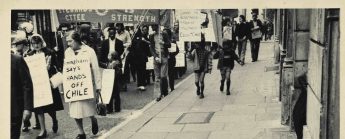
David Gange
It was once a well-worn, nostalgically nationalist, trope that the creation of the modern British Isles had involved the gradual detachment of society from ‘the land’. There’s more truth, perhaps, in the idea that the processes of modernity led to disengagement from the water. The number of ferry crossings in the Scottish mainland has plummeted over the last two centuries. Hundreds of small island communities have been lost because of clearances, unrealistic rents or just the demands of modern life. Farmland, edgeland and city have been drained and dried out to ease overland movement.

One of the major differences between the late-modern experience of the north-east Atlantic archipelago and that of earlier people comes from this marginalisation of water. It can be tempting for historians to take today’s geography for granted, despite the fact that Britain was turned outside in by roads and rail. The mainland’s arteries – the M1, M6, and even the West Coast Mainline – now run through the spine rather than along the external sea-roads that once predominated. Coasts and islands carry very different meanings than they once possessed: they’re often thought of as being remote and empty where their history is actually one of commerce and communication.
In recent years there has been a great deal of theorisation of movement as both an object of study and a scholarly method: Tim Ingold’s work is an excellent example, as are the outputs of many psychogeographic centres and study groups. Excellent histories, from Gillian Tindall’s Footsteps in Paris to Matthew Kellys’ Quartz and Feldspar have made use of these developments. Yet they usually equate movement with walking on land. In his otherwise wonderful Being Alive: Essays on Movement, Knowledge and Description (2011), Ingold even dismisses all travel over water in a single footnote.
The last couple of years have seen some pushback against that situation, particularly within the growing coastal history movement. The first Coastal History conference was organised by the University of the Highlands and Islands in March this year, bringing together over a hundred scholars interested in the perspectives on history that the edges of land and sea provide. The diversity of methods and ideas about the place of coasts in history was staggering.
It’s in that context that I decide to start a project writing British history from the perspectives of Atlantic coastlines, and to research it by kayak. I’ve now kayaked all the Atlantic coasts of Shetland and Orkney and am currently half way down the Western Isles, meeting bigger seas than I’ve had to deal with so far:

The book that results from this will be called The Frayed Atlantic Edge: a Historian’s Journey from Shetland to the Channel and will be published by Harper Collins. You can find more about it at www.frayedatlanticedge.com
Places such as Shetland and Lewis are astonishingly culturally different from one another. One of my tasks is to explore how similar ingredients of weather, land and sea have been transformed into widely divergent communities through the processes of history. This is the itinerary I’ve taken on:

It’s a version of the British Isles in which only the final leg (of 12) takes place in England and the number of languages encountered will be greater than many people realise exist in this region.
Although the coast itself – littered with the ruins of millennia and full of communities with long collective memory – is the main archive, this is also a kayak between some extraordinary archival collections. Ironically, many places that often go unmentioned in general histories of Britain – Shetland, Orkney, Lewis – have some of the best resources.
The Shetland Museum and Archive is perhaps the most wonderful archive I’ve ever used: it’s huge, well-staffed and prominent in Shetland life. The Orkney Sound Archive is full of extraordinary descriptions of uses of the sea from generations of Orcadians.
Alongside the large central repositories, there are a host of rich local collections. From the archive of the Unst Boat Haven, to those of the Westray Heritage Centre and Comunn Eachdraidh Nis (Ness Historical Society on Lewis) there’s an extraordinary amount of material that is well-thumbed by those writing local studies but entirely unintegrated into general British histories.
These are also regions in which experiments in historical method have been different than elsewhere. The Gaelic scholar Domhnall Uilleam Stiubhart has, for instance, written intriguing things on the use of oral studies for the medieval and early modern history of Lewis. The archaeologists Antonia Thomas and Dan Lee have done fantastic work on the meanings of the Norse and Neolithic landscapes of Orkney to nineteenth and twentieth century crofters. The idea of ‘the archive of the feet’, championed by historians such as Jim Hunter, is better established for these Atlantic edges than anywhere else in Britain.
So there’s an extraordinary amount to work with in attempting to conceptualise how British history looks from the perspective of these coastlines. The effort to find ways of writing about how movement and observation from the water can be a historical method might need a little more ingenuity. Another priority, in our current historical climate, will be to find a mode of writing in which people, environment and animals play equal roles. After all, I’m rarely waking up from my waterproof sleeping bag without finding something staring me in the eye:


